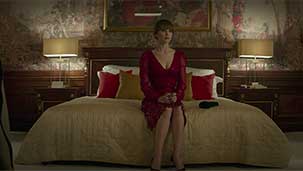Anyone nostalgic for the good old days of the Cold War world order must be super-happy right now. Once again, there’s a crook in the White House while America and Russia shake their dicks at each other. Or, if your view aligns more closely with a character in Francis Lawrence’s Red Sparrow, the Cold War never really ended. Either way, the ’evil Russians’ spy thriller has a new lease on life - what was old is new again. Although set in the present day, Red Sparrow evokes classic Cold War-era narrative conventions and aesthetics to reiterate the central theme of history repeating itself.
I have a soft spot for espionage capers that vilify the Russians, if for no other reason than they provide a brief respite from Hollywood’s incessant vilification of brown people. Even the clunkiest, most overwrought Red Scare throwback is fine by me (The Hunt for Red October remains a guilty pleasure with no guilt and ceaseless pleasure), which is why I liked Red Sparrow, but I fear it ultimately falls flat in its purpose.
Tying past to present occurs throughout the film in numerous ways, some more effective than others. Transporting or intercepting a key piece of physical evidence or intelligence is a common plot element in the spy thriller, and in Red Sparrow, the intelligence in question is a set of plans or schematics for someone’s space satellite something-or-other. Here, the old-meets-new gimmick does not land well, because no matter how retro you’re trying to be, no one is storing highly classified intel on a bunch of floppy disks. And so, a scene that should have served to build tension and instill a sense of peril in the audience becomes unintentionally comical as Jennifer Lawrence’s titular Mata Hari scrambles to swap out one set of disks for another, and at least one person in the audience goes, “LOL, floppy disks?” (I swear it wasn’t me).
Probably my favourite thing about Hollywood trying to pull off a Russian spy thriller is Hollywood actors trying to pull of Russian accents, all, “Ve haff been vaiting for you, komredd…” Here, Red Sparrow delivers in spades - unfortunately. When Jennifer Lawrence venomously mutters, “You sent me to WHORE SCHOOL” in her best Boris & Natasha imitation, you almost feel the dialect coach’s soul die a little bit. Everyone makes a valiant effort at the sinister Slavic rolling of ’r’s, but in my humble opinion, this never, ever works, and is so distracting, making it hard to take the film seriously.
The one element that works beautifully, though, is the set decoration. If not for the presence of modern cars and technology, I would have had trouble initially situating the film in time. You meticulously recreated the Soviet-era aesthetic, with a drab colour pallet and claustrophobic interiors, to make the connection between past and present. The sets flawlessly complement the cinematography in representing the Dominika’s inner state; where she feels trapped, versus the fleeting moments where she feels free. The various apartments she finds herself in are a great example; dingy, dimly lit, cramped quarters in Moscow versus rooms with larger windows, higher ceilings, more natural light when she arrives in Budapest. Your sets immediately made me think of a few other works from contemporary Russian cinema that also rely heavily upon the same aesthetic.
All this to say, I respect what Red Sparrow tries to do, but too many of its elements end up being unintentionally comedic, which I didn’t mind at all, but ultimately isn’t their intended purpose. It would be one thing if the sole aim was for the film to be an homage to the old-school Cold War spy thriller, but it clearly wants to be taken more seriously as a commentary on history repeating itself, and this is where a lot of the old-school elements fail to stick the landing.
Best,

Nat







